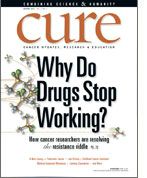Publication
Article
CURE
Post-Mastectomy Pain Hits a Nerve
Author(s):
Pain after breast cancer surgery can be persistent and debilitating.
Pain after major surgery is to be expected, but pain persisting beyond the normal healing period is considered chronic. Post-mastectomy pain syndrome (PMPS) is a type of chronic pain that occurs after breast cancer surgeries such as mastectomy, lumpectomy and axillary lymph node dissection, which involves removing lymph nodes in the underarm region. Pain from PMPS has been described as a burning sensation; a shooting, stabbing pain; or a throbbing, aching or oppressing pain. Study results vary, but show that anywhere from 20 to 68 percent of breast cancer survivors experience PMPS. This condition can develop up to several months after surgery and can persist for three to six or more years.
Direct injury to the intercostobrachial nerve and other sensory nerves in the underarm (axilla) and breast areas during surgery causes PMPS. Subsequent formation of scar tissue from surgery for breast cancer may also be a cause. And, contrary to its name, studies have shown that PMPS may occur more often after breast-conserving therapy (lumpectomy) than after modified radical mastectomy.
Studies have also shown that the risk of PMPS may increase with the extent of axillary intervention, as axillary dissection has been shown to be a critical component in chronic pain following breast cancer surgery. Other factors that increase the risk of PMPS include treatment with radiation or chemotherapy after surgery, younger age (under 40) at time of diagnosis and larger tumor size. A tumor located in the upper, outer quarter of the breast (near the underarm) also increases the risk of PMPS because surgery in this area carries a higher risk of nerve damage.
Pain from PMPS typically occurs in the upper arm, underarm region, shoulder and chest wall—areas served by the damaged intercostobrachial nerve. However, pain could also occur in the surgical scar. PMPS symptoms might also include abnormal sensations, such as an electric-shock type of pain that overlies a constant aching and burning feeling.
The pain can be mild and manageable, or severe enough to interfere with daily activities. It could also impair movement or use of the affected arm, which can lead to stiffness, pain and limited shoulder rotation, a condition called frozen shoulder. PMPS symptoms can be continuous or intermittent, with pain occurring every day or only a few days a week. The pain can also be aggravated or worsened by shoulder strain, household chores and even simple stretching.
Managing the symptoms of PMPS is important not only for pain relief but also to reduce the negative impact it can have on daily activities and quality of life. Initial treatment can involve routine use of nonsteroidal anti-inflammatory drugs (NSAIDs), such as ibuprofen. Pain limited to the surgical scar can often be managed with injections of a local anesthetic or steroid. Capsaicin cream, a topical anesthetic, has also been shown to be effective for scar pain. Sometimes more extensive pain management is required. In these cases, antidepressants, such as amitriptyline, anticonvulsants, such as gabapentin, and opioids, such as oxycodone, can be used to relieve neuropathic pain. Another option is a nerve block, which involves injecting an anesthetic or steroid into the nerves of the affected area.
Non-drug interventions can also be helpful, and include massage therapy, acupuncture, reflexology and counseling. Physical therapy with arm and shoulder exercises is also helpful when it comes to increasing range of motion to prevent frozen shoulder.





